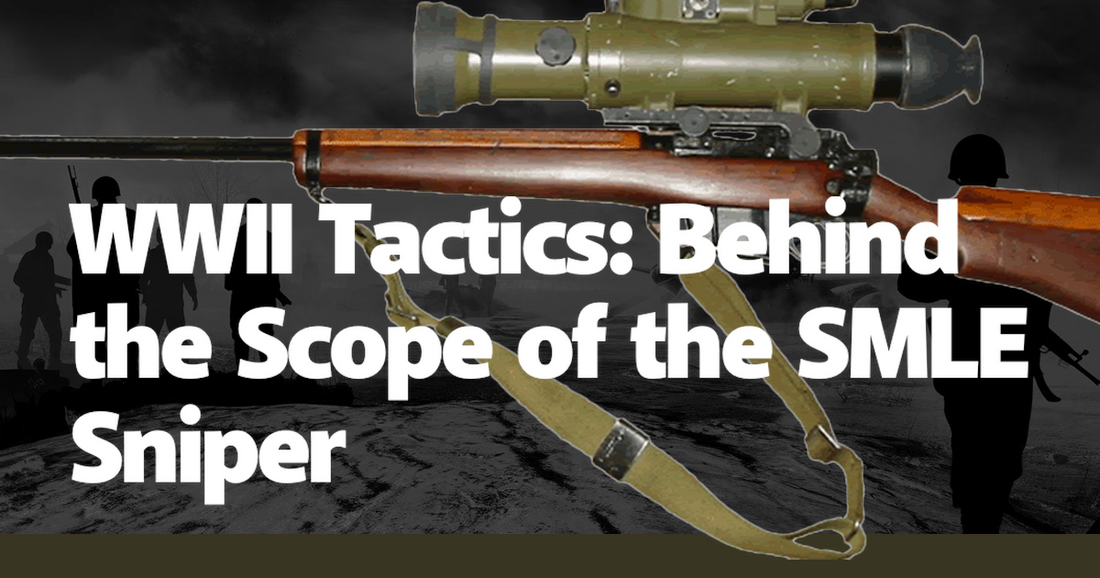The Second World War was a theater of innovation and adaptation, where tactics evolved rapidly to meet the demands of a global conflict. Among the many weapons that defined this era, the Short Magazine Lee-Enfield (SMLE) sniper rifle stood out for its precision and reliability. As the war raged across diverse terrains—from the deserts of North Africa to the dense forests of Europe—snipers armed with the SMLE played a pivotal role in shaping the battlefield. The SMLE, initially designed as a standard infantry rifle, was adapted into a sniper variant that became a formidable tool in the hands of skilled marksmen. Its robust design, coupled with a powerful scope, allowed snipers to engage targets at long ranges with deadly accuracy.
The SMLE sniper rifle, officially designated as the No. 4 Mk I (T), was a product of British ingenuity. Its development was driven by the need for a reliable, accurate weapon that could perform under the harshest conditions. The rifle featured a 10-round magazine, a significant advantage over the bolt-action rifles used by other nations, which typically held fewer rounds. This allowed snipers to engage multiple targets without the need to reload frequently, a critical factor in maintaining the element of surprise. The SMLE's bolt-action mechanism was smooth and fast, enabling rapid follow-up shots, which was essential in the dynamic and often chaotic environments of WWII.
The effectiveness of the SMLE sniper was not solely due to the rifle itself but also to the training and skill of the snipers who wielded it. British snipers underwent rigorous training that emphasized marksmanship, camouflage, and fieldcraft. They were taught to move silently, blend into their surroundings, and remain patient for extended periods, waiting for the perfect shot. This training was put to the test in various campaigns, where snipers played crucial roles in reconnaissance, disrupting enemy supply lines, and eliminating high-value targets. Their ability to operate independently and make quick, decisive actions made them invaluable assets on the battlefield.
One notable example of the SMLE sniper's impact was during the Battle of El Alamein in 1942. In the vast deserts of North Africa, British snipers used the SMLE to great effect, targeting German officers and artillery crews. The long-range capabilities of the rifle allowed snipers to engage targets from concealed positions, often from distances that made counter-sniping efforts difficult. This demoralized enemy troops and disrupted their command and control structures, contributing to the overall success of the Allied forces in this critical battle. The psychological impact of snipers, who could strike without warning, cannot be overstated. Their presence instilled fear and uncertainty in enemy ranks, forcing them to alter their tactics and movements.
In the dense forests and urban ruins of Europe, the SMLE sniper rifle proved equally effective. During the Normandy campaign, snipers were tasked with clearing German machine gun nests and observing enemy movements. The rifle's accuracy allowed them to take precise shots through narrow windows and across open fields, supporting the advancing infantry. The scope, often a No. 32 3.5x telescopic sight, provided clear optics that were crucial for identifying targets in the chaotic and cluttered battlefields. Snipers would often work in pairs, with one acting as a spotter, enhancing their effectiveness and survivability. This teamwork was essential in identifying and engaging targets while minimizing exposure to enemy fire.
The adaptability of the SMLE sniper rifle was further demonstrated in the Pacific Theater, where Australian and British forces faced the Japanese. The dense jungles presented unique challenges, requiring snipers to be even more adept at camouflage and stealth. The SMLE's reliability in harsh conditions, including humidity and mud, made it a preferred choice. Snipers used the rifle to ambush enemy patrols and gather intelligence, often operating deep behind enemy lines. Their ability to disrupt supply lines and communication networks was instrumental in the island-hopping campaigns that characterized the Pacific War. The resilience and versatility of the SMLE sniper rifle, combined with the ingenuity of the snipers, showcased its value in diverse combat environments.
The legacy of the SMLE sniper rifle extends beyond its technical specifications and battlefield successes. It represents the ingenuity and adaptability of the soldiers who used it. The stories of these snipers, their bravery, and their skill, are a testament to the human element in warfare. One such story is that of Sergeant H.A. Marshall, a British sniper who achieved remarkable feats with his SMLE during the Italian campaign. His ability to remain undetected for days, patiently waiting for the perfect shot, exemplified the dedication and discipline required of snipers. Marshall's actions not only saved countless lives but also inspired his comrades, highlighting the profound impact a single well-placed shot could have on the outcome of a battle.
In conclusion, the SMLE sniper rifle was more than just a weapon; it was a symbol of precision, reliability, and adaptability. Its role in WWII was significant, providing Allied forces with a tool that could engage targets with deadly accuracy across various terrains and conditions. The training and skill of the snipers who wielded it were equally crucial, showcasing the importance of marksmanship and fieldcraft in modern warfare. The stories of these snipers, their successes, and their sacrifices, continue to inspire and remind us of the critical role that precision and patience play in the art of war.

